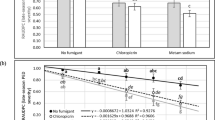Abstract
Preplant soil fumigation with methyl bromide (MB) is presently standard practice in greenhouse tomato production. Since this compound is scheduled to be phased out by 2005, the possibility of using solarization as an alternative soil disinfestation method was examined in four greenhouse tomato trials. Solarization was applied for 8 weeks in July-August, using transparent polyethylene sheets for soil mulching, and compared with MB fumigation applied in September, before planting, at 80 g/m2. Solarization raised the maximum soil temperature by 9°C and reduced the population density ofFusarium spp. in soil by 91–98%. Similar reductions of soil inoculum (95–99%) were obtained with MB fumigation. Both methods provided effective control of Fusarium wilt, Verticillium wilt and corky root rot on tomato plants. MB fumigation was in addition highly effective against root-knot nematodes, whereas nematode control with solarization did not exceed 50%. Both treatments resulted in similar fruit yield increases, ranging within 90–140% compared with plants grown in untreated soil. During the second cropping season following soil treatment, solarization exhibited two times higher residual effectiveness against vascular wilt diseases compared with MB fumigation. The latter treatment, however, was superior to solarization in its residual effectiveness against root-knot nematodes and to a lesser extent against corky root rot. Fruit yields from solarized and MB-fumigated soil during the second cropping season were higher than those obtained from untreated soil by approximately 35% and 60%, respectively. In Cyprus, solarization appears to be an effective alternative to MB fumigation in greenhouse tomato production, especially if integrated with other approaches enabling more effective nematode control.
Similar content being viewed by others

References
DeVay, J.E. and Katan, J. (1991) Mechanisms of pathogen control in solarized soils. pp. 97–101.in: Katan, J. and Devay, J.E. [Eds.] Soil Solarization. CRC Press, London, UK.
DeVay, J.E. and Stapleton, J.J. (1997) Soil solarization: past, present, and future. pp. 1–5.in: Stapleton, J.J., DeVay, J.E. and Elmore, C.L. [Eds.] Soil Solarization and Integrated Management of Soil-borne Pests. Plant Production and Protection Paper 147, FAO, Rome, Italy.
Elmore, C.L. (1991) Weed control by solarization. pp. 61–72.in: Katan, J. and DeVay, J.E. [Eds.] Soil Solarization. CRC Press, London. UK.
Greco, N., Addabbo, D., Brandonisio, A. and Zweep, A. (1990) Combined effect of soil solarization and 1,3-dichloropropene for control ofHeterodera carotae.Nematol. Mediterr. 18:261–264.
Ioannou, N. (1999) Management of soilborne pathogens of open-field tomato with soil solarization.Tech. Bull. 205, Agricultural Research Institute, Nicosia, Cyprus.
Ioannou, N. and Poullis, C.A. (1990) Evaluation of soil solarization for control of Fusarium wilt of watermelon.Tech. Bull. 121, Agricultural Research Institute, Nicosia, Cyprus.
Ioannou, N., Poullis, C.A. and Heale, J.B. (1998) Management of Fusarium wilt of watermelon with soil solarization in combination with low rates of methyl bromide or high rates of ammonium fertilizers.Abstr. 9th Hellenic Phytopathological Congr. (Athens, Greece), p. 49.
Ioannou, N., Poullis, C.A. and Heale, J.B. (1998) Widespread occurrence of race 2 ofFusarium oxysporum f.sp. niveum in watermelon crops in Cyprus and its control with resistant rootstocks.Abstr. 9th Hellenic Phytopathological Congr. (Athens, Greece), p. 50.
Katan, J. (1980) Solar pasteurization of soils for disease control: status and prospects.Plant Dis. 64:450–454.
Katan, J. (1981) Solar heating (solarization) of soil for control of soilborne pests.Annu. Rev. Phytopathol. 19:211–236.
Katan, J. (1987) Soil solarization. pp. 77–105.in: Chet, I. [Ed.] Innovative Approaches to Plant Disease Control. John Wiley & Sons, New York, NY.
Katan, J., Greenberger, H.A. and Grinstein, A. (1976) Solar heating by polyethylene mulching for the control of diseases caused by soilborne pathogens.Phytopathology 28:28–32.
Katan, J., Fishier, G.L. and Grinstein, A. (1983) Short- and long-term effects of soil solarization and crop sequence on Fusarium wilt and yield of cotton in Israel.Phytopathology 73:1215–1219.
Morgan, D.P., Liebman, J.A., Epstein, L. and Pimenez, M.J. (1991) Solarizing soil planted with cherry tomatoes vs. solarizing fallow ground for control of Verticillium wilt.Plant Dis. 75:148–151.
Noling, J.W. and Becker, J.O. (1994) The challenge of research and extension to define and implement alternatives to methyl bromide.J. Nematol. 26:573–586.
Papavizas, G.C. (1967) Evaluation of various media and antimicrobial agents for isolation of Fusarium from soil.Phytopathology 57:848–852.
Philis, J. (1983) Occurrence ofMeloidogyne spp. and races on the island of Cyprus.Nematol. Mediterr. 11:13–19.
Philis, J. (1990) The efficacy of nematode resistant tomato cultivars toMeloidogyne javanica under greenhouse conditions.Nematol. Mediterr. 18:209–211.
Porter, I.J. and Merriman, P.R. (1985) Evaluation of soil solarization for control of root diseases of row crops in Victoria.Plant Pathol. 34:108–118.
Pullman, G.S., DeVay, J.E. and Garber, R.H. (1981) Soil solarization and thermal death: a logarithmic relationship between time and temperature for the soil-borne plant pathogens.Phytopathology 71:959–964.
Saleh, H., Abu-Gharbieh, W.I. and Al-Banna, L. (1989) Augmentation of soil solarization effects by application of solar-heated water.Nematol. Mediterr. 17:127–129.
Stapleton, J.J. (1997) Modes of action of solarization and biofumigation. pp. 78–88.in: Stapleton, J.J., DeVay, J.E. and Elmore, C.L. [Eds.] Soil Solarization and Integrated Management of Soil-borne Pests. Plant Production and Protection Paper 147, FAO, Rome, Italy.
Stapleton, J.J. and DeVay, J.E. (1984) Thermal components of soil solarization as related to changes in soil and root microflora and increased plant growth response.Phytopathology 74:255–259.
Stapleton, J.J. and Heald, C.M. (1991) Management of phytoparasitic nematodes by soil solarization. pp. 51–60.in: Katan, J. and DeVay, J.E. [Eds.] Soil Solarization. CRC Press, London, UK.
Stapleton, J.J., Paplomatas, E.J., Wakeman, R.J. and DeVay, J.E. (1993) Establishment of apricot and almond trees using soil mulching with transparent (solarization) and black polyethylene film: effects on Verticillium wilt and. tree health.Plant Pathol, 42:333–338.
Author information
Authors and Affiliations
Corresponding author
Rights and permissions
About this article
Cite this article
Ioannou, N. Soil solarization as a substitute for methyl bromide fumigation in greenhouse tomato production in Cyprus. Phytoparasitica 28, 248–256 (2000). https://doi.org/10.1007/BF02981803
Received:
Revised:
Issue Date:
DOI: https://doi.org/10.1007/BF02981803



